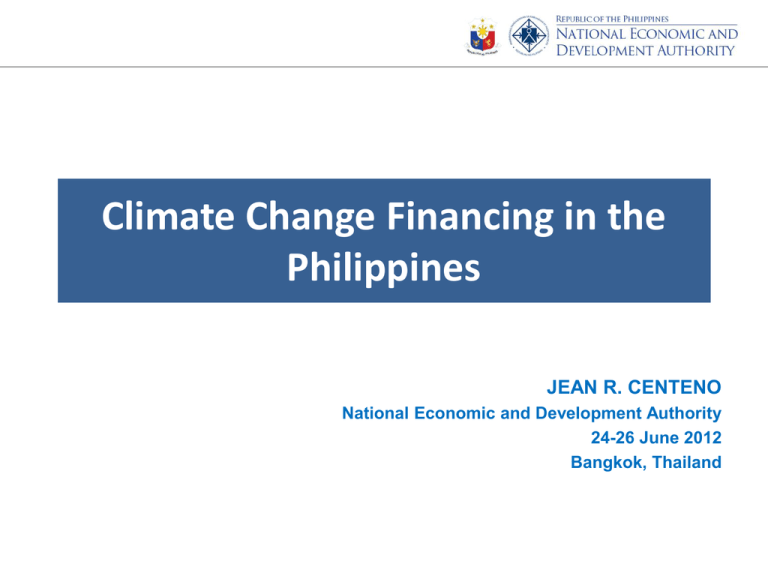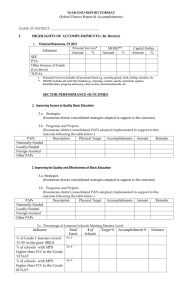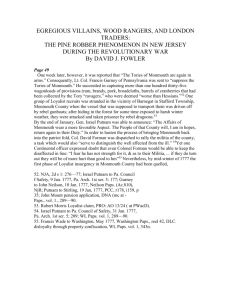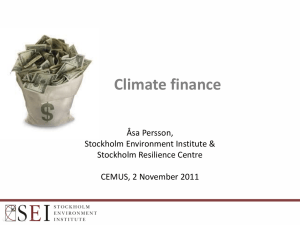Philippines - Asia Pacific Adaptation Network
advertisement

Climate Change Financing in the Philippines JEAN R. CENTENO National Economic and Development Authority 24-26 June 2012 Bangkok, Thailand Outline of Presentation I. Mainstreaming Climate Change (CC) in the 2011-2016 Philippine Development Plan and the 2011-2016 Public Investment Program II. Reported Programs and Projects (PAPs) in the 2011 Official Development Assistance (ODA) Report a. Percentage Share of CC PAPs in the 2011 ODA b. Percentage Distribution of CC PAPs per Sector c. Sources of CC Financing / Existing Financing Window III. Potential Sources of Climate Change Finance IV. Opportunities and Challenges in programming and mobilizing public investment for CC + NARD (16-POINT AGENDA) ACHIEVE INCLUSIVE GROWTH, CREATE EMPLOYMENT OPPORTUNITIES AND REDUCE POVERTY • Anchored on President Benigno S. Aquino III’s “Social Contract with the Filipino People” • Overarching theme: inclusive growth and good governance I. Mainstreaming Climate Change in the 2011-2016 Philippine Development Plan 6 out of 10 chapters of the PDP are CCA/DRR proofed . Strategies espoused in the PDP are consistent with the actions required in the 2011-2028 National Climate Change Action Plan (NCCAP). PDP is currently being revalidated to ensure that strategies remain relevant and achievable. Major CC/DRR/M Strategies in the 2011-2016 PDP • Strengthening institutional capacities of national and local governments for CCA and DRR • Improving adaptive capacities of communities to the impact of climate change • Building resilience of the natural ecosystems • Promotion of environment friendly technologies for industry and transportation sectors • Promotion of clean and renewable energy Mainstreaming Climate Change Adaptation and Disaster Risk Reduction in the 2011-2016 Public Investment Program Sector # of % (US$ billion) Projects Share Cost Agriculture & Agrarian Reform 0.06 25 <1 ENR 1.32 21 17.75 CCA and DRR/M (including flood control) 3.30 91 45 Energy and Power Total 2.74 7.42 32 169 37 100 Typology of activities • formulation/enhancement of AFM plans • promotion of technologies for CC in agriculture • capacity building including IEC on CC • formulation/enhancement of ENR framework plan; • integration of CC technologies in watershed management/forestry, biodiversity conservation, solid waste management, and sewerage system activities; and • capacity building including IEC on CC • formulation/enhancement of local land use plans; • installation of early warning system, forecasting/modeling device, hydrometeorological equipment; and • capacity building including IEC • construction of dams • promotion of Renewable Energy II. ODA Programs and Projects (PAPs) with CC Components Percentage Share of CC PAPs in the 2011 ODA CC PAPs Adaptation Loan Grant Mitigation Loan Grant Adaptation and Mitigation Loan Grant Total No. of Projects 43 11 32 13 3 10 22 Cost (US$ billion) 1.84 1.75 0.09 0.18 0.14 0.04 0.19 % Share 83.2 94.6 5.4 8.3 80 20 8.5 4 18 78 0.12 0.07 2.21 64 36 100 Source No. of Projects % Share Loan 18 23 Grants 60 77 Total 78 100 Percent distribution of 2011 CC PAPs per sector/category Percentage Share of CC PAPs in the 2011 ODA 8% 8% Adaptation Mitigation Adaptation & Mitigation Percentage Distribution of CC PAPs per Sector 83% 14% 42% Rural Development ENR Energy and Power CCA/DRR/M 36% 7% Sources of 2011 CC PAPs Financing 1. Multi-lateral Sources ADB, FAO, GEF, IFAD, MDGF, UNDP, UNEP, UNIDO, and WB (e.g., through the climate change window on Special Climate Change Fund – SCCF) 2. Bilateral Sources AUSAID, Austria, China, Czech Republic, Germany (BMZ, GIZ, KfW or through Initiative for Climate and the Environment - IKLU), Japan (JICA, KOICA, JIRCAS or through Cool Earth Partnership ) New Zealand, Norway, Spain, and USAid Percentage of CC Allocation per Fund Source 44% 56% Multilateral Bilateral III. Potential Sources of CC Finance Name of Facility Philippine Survival Fund (PSF) - Republic Act 10174 Features/Terms and Conditions Status • Domestic “rewards fund” Implementing Rules and aimed at addressing urgent Regulations for RA 10174 adaptation needs submitted to the President • Finance adaptation programs for his review and approval. and projects that are directly supportive to the NCCAP • Sources of the PSF managed by the Fund Board PhP1 billion from the national budget Augmented by donations, grants, endowments III. Potential Sources of CC Finance Name of Facility Features/Terms and Conditions Status Adaptation Fund (AF) About USD 109.3M funds available as • Available but there is a need - Established to finance of 2011 and expected to increase to concrete adaptation for the country to establish about USD 204M by end 2012 projects and programmes in the NIE to directly access the developing country-Parties AF. It has three modalities, namely: to the Kyoto Protocol and a) National Implementing Entity (NIE) are particularly vulnerable - Requires a Designated Authority to the adverse effects of to endorse adaptation programs climate change and projects for the country - USD 10M cap per country - Financed from voluntary contribution of Annex1 b) Multilateral Implementing Entity country-Parties and (2%) (MIE) share of proceeds of CDM - Cap of 50% of the total project adaptation fund c) Regional Implementing Entity (RIE) III. Potential Sources of CC Finance Name of Facility Features/Terms and Conditions Green Climate Fund • A total of USD 100B annual (GCF) funds from developed - Established as an countries for climate change operating entity of the adaptation and mitigation financial mechanism of activities. the Convention under Article 11. - The GCF will support projects, programmes, policies & other activities in developing country Parties. The Fund will be governed by the GCF Board. Status • Mechanism to access funds and institutional arrangement are still being determined. • Designation of the Philippines as member/alternate to the GFC Board. IV. Opportunities and Challenges in programming and mobilizing public investment for CC A. Opportunities • CC strategies are already identified as priority in the 2011-2016 PDP as well as local and sectoral plans • Availability of success stories on pilot projects/interventions on CC/DRRM which can be upscaled • CC projections and sectoral vulnerability assessment conducted as basis for CC interventions design • Availability of funding window to support implementation of CC/DRR/M initiatives IV. Opportunities and Challenges in programming and mobilizing public investment for CC B. Challenges • Logical tagging/classification of CC and DRR/Mrelated PAPs • Harmonization of PAPs identified in the 2011-2016 PIP with the interventions/PAPs geared toward achieving the immediate outcomes of the NCCAP • Capacity building for implementing climate change actions • Further involvement of sub-national actors at the planning stage End of Presentation











